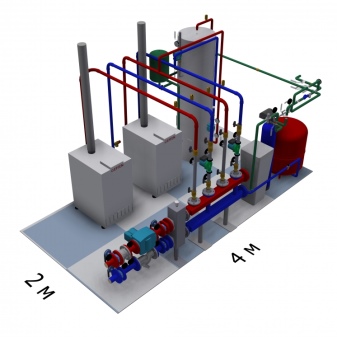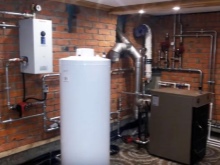Sizes of gas boiler rooms in private houses

The dimensions of gas boiler houses in private houses are far from idle information, as it might seem. Strict minimum dimensions for different boilers in accordance with SNiP have been set for a long time. There are also specific regulations and requirements for different premises, which also cannot be ignored.


Basic standards
Heating equipment is mainly installed in domestic boiler rooms, but it must be understood that such devices can be dangerous. It is necessary to take into account the strict requirements enshrined in SNiPs. Usually the location of heating equipment is provided in:
- attics;
- detached outbuildings;
- self-contained containers (modular type);
- the premises of the house itself;
- extensions to buildings.
The minimum size of a gas boiler room in a private house is:
- 2.5 m in height;
- 6 sq. m in area;
- 15 cubic meters m in total volume.
But the list of norms does not end there. The standards introduce prescriptions for individual parts of the premises. So, the area of kitchen windows must be at least 0.5 m2. The smallest door leaf width is 80 cm.The size of the natural ventilation channels is at least 40x40 cm.



Additionally, you should pay attention to:
- SP 281.1325800 (5th section on room standards);
- 4th part of the code of practice 41-104-2000 (an earlier version of the previous document with slightly more stringent regulations);
- clauses 4.4.8, 6.2, 6.3 of the set of rules 31-106 of 2002 (instructions for the installation and for the equipment of the boiler);
- SP 7.13130 as amended in 2013 (provisions on the output of the chimney part to the roof);
- set of rules 402.1325800 in the 2018 version (the order of the arrangement of gas appliances in kitchens and boiler rooms);
- SP 124.13330 of 2012 (norms regarding the heating network when placing a boiler room in a separate building).


Boiler room volume for different boilers
If the total heat generation is up to 30 kW, then it is required to install the boiler in a room of at least 7.5 m3. It is about combining a room for a boiler with a kitchen or integrating it into a home space. If the device emits from 30 to 60 kW of heat, then the minimum volume level is 13.5 m3. It is allowed to use annexes or detached areas on any level of the building. Finally, if the power of the device exceeds 60 kW, but is limited to 200 kW, then a minimum of 15 m3 of free space is required.
In the latter case, the boiler room is placed at the choice of the owner, taking into account engineering recommendations in:
- annex;
- any of the rooms on the first floor;
- autonomous structure;
- base;
- dungeon.


Requirements for different rooms
When designing a boiler room, one should be guided by at least three sets of rules (SP):
- 62.13330 (valid since 2011, dedicated to gas distribution systems);
- 402.1325800 (put into circulation since 2018, reflects the design standards for gas complexes in residential buildings);
- 42-101 (in operation since 2003, in a recommendatory mode describes the procedure for the design and preparation of gas distribution systems based on a non-metallic pipe).
Separately, it is worth mentioning another recommendatory instruction, which relates to the installation of heating units responsible for heating and supplying hot water in single-family and block houses. When drawing up accurate projects, they are guided by all these documents, for example, in order to correctly stretch the pipes and correctly position all the connection points. When determining the size of the boiler room, they are guided by the norms in terms of the distances between the components, in the size of the passages.
Important: no matter what the parameters of the equipment are, it is still better to focus on the minimum total area of the boiler complex not less than 8 m2.


If you install all the necessary equipment along one of the walls, then the devices usually occupy 3.2 m in length and 1.7 m in width, taking into account the necessary passes or distances. Of course, in a particular case, there may be any other parameters, and therefore one cannot do without consulting engineers anyway. It should be understood that the estimated dimensions of equipment and sites are always given without taking into account the space for opening doors and windows.
For your information: you should not be guided by the norms of SP 89. They only apply to heat generating plants with a power rating of 360 kW. At the same time, buildings for such boiler houses occupy at least 3000 sq. m. Therefore, references to such a standard when designing a heating system for a private house are simply illegal. And if they try to introduce them, then this is a sign of unprofessional engineers or even a scam.
The volume of 15 m3 mentioned above is in reality extremely small. The fact is that in reality it is only 5 square meters. m, and this is very little for the installation of equipment. Ideally, you should focus on at least 8 square meters. m or in terms of a volume of 24 cubic meters. m.
Important: the location of the boiler room on the 2nd floor is possible only in extremely rare cases. To do this, it is necessary that it is located 100% above the technical rooms, while not being next to the sleeping areas.


The height of the boiler room must certainly be at least 2.2 m.In various rooms, there must be at least 9 m between the floor of the boiler room and the window of the upper floor. This means that it is forbidden to equip windows above the boiler extension, and with them living rooms. With a total area of the house less than 350 sq. m, you can, in general, abandon the equipment of a separate boiler room in the full sense of the word, taking the kitchen (kitchen-dining room) under the boiler. State auditors will only check that the equipment capacity is not more than 50 kW, and the kitchen volume is at least 21 cubic meters. m (with an area of 7 m2); for a kitchen-dining room, these indicators will be at least 36 cubic meters. m and 12 m2, respectively.
When installing the boiler in the kitchen, the main part of the auxiliary equipment (boilers, pumps, mixers, manifolds, expansion tanks) is placed under the stairs or in a cabinet measuring 1x1.5 m. But when characterizing the size of the boiler room, one must not forget about the requirements for the dimensions of the glazing. They are selected in such a way that the house does not suffer from explosions or suffer minimally. The total area of glass (excluding frames, latches and the like) is at least 0.8 square meters. m even in the control room from 8 to 9 m2 in area.



If the total space of the boiler room exceeds 9 sq. m, then the calculation is also simple. For each cubic meter of a thermal structure, 0.03 m2 of clean glass cover is allocated. A typical window size does not have to be considered specially, it is enough to be guided by a simple ratio:
- hall up to 10 squares - glazing 150x60 cm;
- a complex of 10.1-12 squares - 150x90 cm;
- 12.1-14 m2 - correspond to glass 120x120 cm;
- 14.1-16 m2 - frame 150 x 120 cm.
The above figures for a 80 cm wide door are generally correct, but sometimes insufficient. It is more correct to assume that the door should be 20 cm wider than the boiler or boiler. If there is a discrepancy, their values are guided by the larger apparatus. For the rest, you can limit yourself only to considerations of your own convenience and practicality. A separate topic is the size of the ventilation duct (which is also directly related to the boiler output):
- up to 39.9 kW inclusive - 20x10 cm;
- 40-60 kW - 25x15 cm;
- 60-80 kW - 25x20 cm;
- 80-100 kW - 30x20 cm.



The dimensions of gas boiler rooms in private houses are in the video below.













The comment was sent successfully.